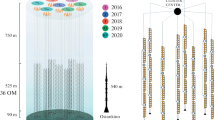Abstract
Baikal-GVD is a deep-underwater neutrino detector of cubic-kilometer scale. It is designed to detect astrophysical neutrinos up to multi-PeV energies and beyond. The deployment of this facility began in spring 2015. Since April 2020, the detector includes seven clusters, each consisting of eight strings carrying in total 288 optical modules located at depths of 750 to 1275 m. By the end of the first phase of construction of the detector in 2024, it is planned to deploy 15 clusters, whereby an effective volume of 0.75 km\({}^{3}\) for detecting high-energy cascades would be reached. The design and status of the Baikal-GVD detector are described in the present article along with selected results of data analysis.





Similar content being viewed by others
REFERENCES
M. A. Markov, in Proceedings of the 1960 Annual International Conference on High-Energy Physics, Rochester, 1960, Ed. by E. C. G. Sudarshan, J. H. Tinlot, and A. C. Melissinos.
IceCube Collab. (M. G. Aartsen et al.), Science (Washington, DC, U.S.) 342, 1242856 (2013).
IceCube Collab (.M. G. Aartsen et al.), in Proceedings of the Very Large Volume Neutrino Telescopes (VLVnT-2018), EPJ Web Conf. 207, 02005 (2019).
The IceCube Collab. et al., Science (Washington, DC, U.S.) 361, eaat1378 (2018).
Baikal Collab. (I. A. Belolaptikov et al.), Astropart. Phys. 7, 263 (1997).
Baikal Collab. (V. A. Balkanov et al.), in Proceedings of the 25th ICRC, Durban, South Africa, 1997, astro-ph/9705244v1.
Baikal Collab. (A. D. Avrorin et al.), in Proceedings of the 36th ICRC, Madison, USA, PoS(ICRC2019) 1012 (2019).
Baikal Collab. (A. D. Avrorin et al.), in Proceedings of the 36th ICRC, Madison, USA, PoS(ICRC2019) 878 (2019).
D. Heck, J. Knapp, J. N. Capdevielle, G. Schatz, and T. Thouw, FZKA 6019 (Forschungszentrum Karlsruhe, 1998).
IceCube Collab., in Proceedings of the 36th ICRC, Madison, USA, PoS(ICRC2019) 1004 (2019).
LIGO Scientific Collab. et al., Astrophys. J. Lett. 848, L12 (2017).
ANTARES, IceCube, The Pierre Auger, LIGO Scientific, and Virgo Collabs., Astrophys. J. Lett. 850, L35 (2017).
Super-Kamiokande Collab. (A. Abe et al.), Astrophys. J. Lett. 857, 1 (2018).
Baikal Collab. (A. D. Avrorin et al.), JETP Lett. 108, 787 (2018).
Funding
This work was supported in part by Russian Science Foundation (grant nos. 20-02-00400 and 9-29-11029) and by a grant (no. 20-202-09) from Joint Institute for Nuclear Research for young scientists.
Author information
Authors and Affiliations
Corresponding author
Rights and permissions
About this article
Cite this article
Avrorin, A.V., Avrorin, A.D., Aynutdinov, V.M. et al. Baikal-GVD Experiment. Phys. Atom. Nuclei 83, 916–921 (2020). https://doi.org/10.1134/S1063778820060046
Received:
Revised:
Accepted:
Published:
Issue Date:
DOI: https://doi.org/10.1134/S1063778820060046




